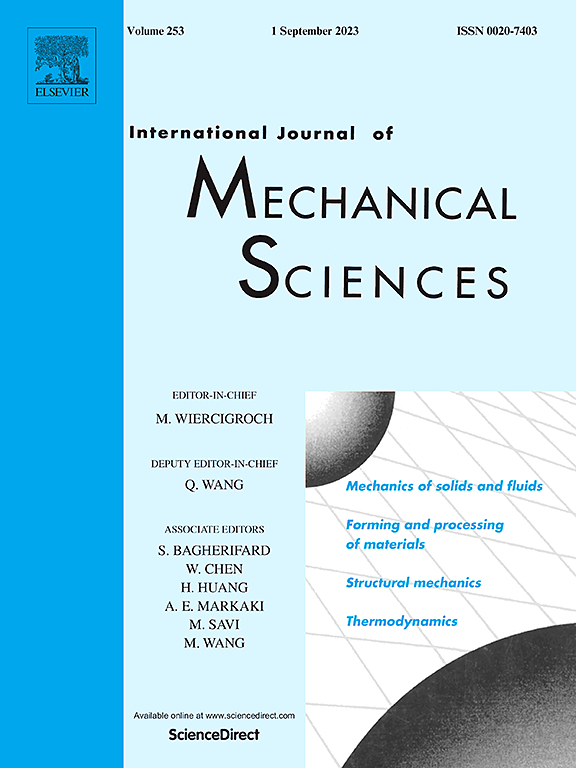Influence of strain rate and temperature on the multiaxial failure stress locus of a polyamide syntactic foam
IF 7.1
1区 工程技术
Q1 ENGINEERING, MECHANICAL
International Journal of Mechanical Sciences
Pub Date : 2025-01-15
DOI:10.1016/j.ijmecsci.2024.109864
引用次数: 0
Abstract
This study introduces a comprehensive experimental methodology allowing for the direct measurement of the rate dependent multiaxial response of polymer syntactic foams under combined direct-shear loading. The combined tension-torsion behaviour of a syntactic foam and its rate dependence are investigated for the first time.
Dynamic tension-torsion experiments were conducted using a newly developed Tension-Torsion Hopkinson Bar (TTHB) enabling the measurement of the combined tensile-shear response of engineering materials at high rates of strain.
The response and multiaxial failure envelope of a polyamide syntactic foam were experimentally measured and analysed to determine the combined influences of stress state, strain rate, and temperature. The multiaxial failure stress locus was defined in both the normal versus shear stress space and the principal stress space, providing a comprehensive characterisation of the behaviour of the material under various loading and environmental conditions.
The suitability of existing pressure dependent failure criteria to represent the measured experimental data was also assessed. The Drucker-Prager pressure dependent criterion proved to be effective in capturing the measured quasi-static and dynamic multi-axial stress loci at different temperatures.
The effects of temperature, loading rate and stress state on the deformation and failure modes were analysed by means of SEM micrographs of the tested samples.

求助全文
约1分钟内获得全文
求助全文
来源期刊

International Journal of Mechanical Sciences
工程技术-工程:机械
CiteScore
12.80
自引率
17.80%
发文量
769
审稿时长
19 days
期刊介绍:
The International Journal of Mechanical Sciences (IJMS) serves as a global platform for the publication and dissemination of original research that contributes to a deeper scientific understanding of the fundamental disciplines within mechanical, civil, and material engineering.
The primary focus of IJMS is to showcase innovative and ground-breaking work that utilizes analytical and computational modeling techniques, such as Finite Element Method (FEM), Boundary Element Method (BEM), and mesh-free methods, among others. These modeling methods are applied to diverse fields including rigid-body mechanics (e.g., dynamics, vibration, stability), structural mechanics, metal forming, advanced materials (e.g., metals, composites, cellular, smart) behavior and applications, impact mechanics, strain localization, and other nonlinear effects (e.g., large deflections, plasticity, fracture).
Additionally, IJMS covers the realms of fluid mechanics (both external and internal flows), tribology, thermodynamics, and materials processing. These subjects collectively form the core of the journal's content.
In summary, IJMS provides a prestigious platform for researchers to present their original contributions, shedding light on analytical and computational modeling methods in various areas of mechanical engineering, as well as exploring the behavior and application of advanced materials, fluid mechanics, thermodynamics, and materials processing.
 求助内容:
求助内容: 应助结果提醒方式:
应助结果提醒方式:


